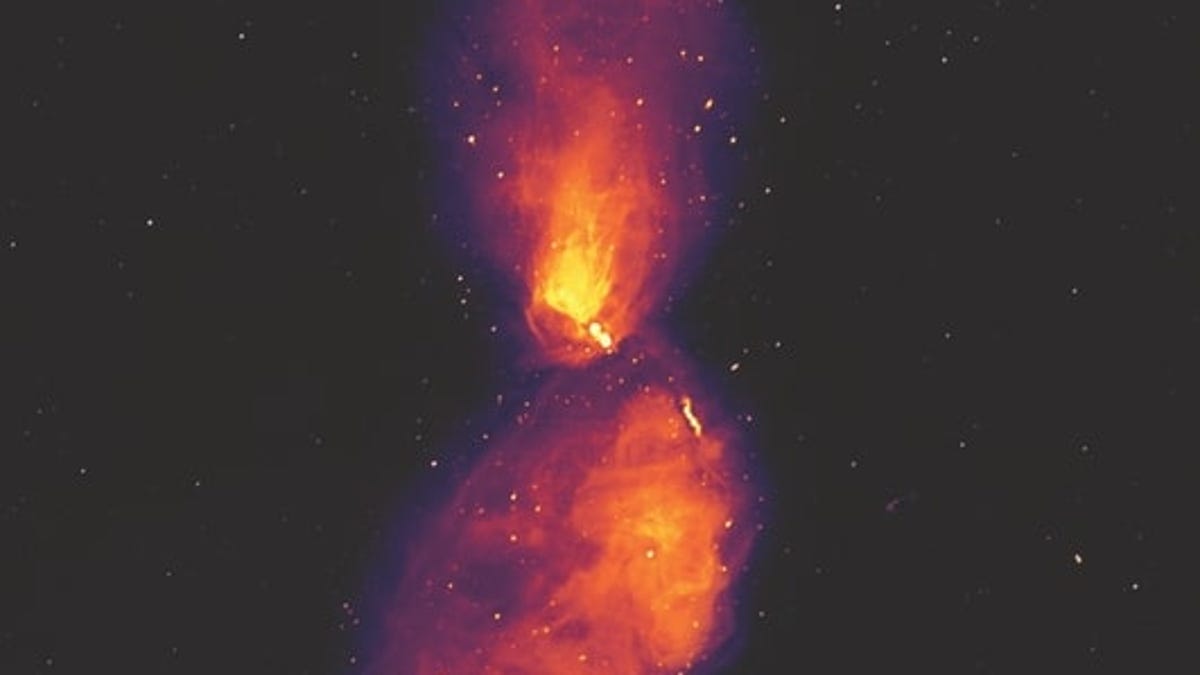This supermassive black hole eruption spans 16 full moons
An abyss next door is making a scene, giving us a beautiful new image of cosmic disarray.

This image shows the galaxy at radio wavelengths, revealing vast lobes of plasma that reach far beyond the visible galaxy, which occupies only a small patch at the center of the image. The dots in the background aren't stars, but radio galaxies much like Centaurus A, at far greater distances.
Some 12 million light-years from Earth, the Milky Way's galactic neighbor is experiencing a bit of chaos. The culprit? A hangry black hole with the mass of 55 million suns.
For hundreds of millions of years, this supermassive void has been feasting away at the gas falling in from its surrounding galaxy, Centaurus A, then torching the material back out at nearly the speed of light. Now, scientists have caught the moody abyss in its tracks.
With the help of a heavy-duty radio telescope, the Murchison Widefield Array in Australia, astronomers captured the black hole's massive jets of discarded matter spewing out from its center. If we could see the eruption with our naked eye from here on Earth, it'd be the size of 16 full moons back-to-back in the sky, the team says.
They published a paper on an image of the flare-up, produced from radio wave data, Wednesday in the journal Nature Astronomy. "We can learn a lot from Centaurus A in particular, just because it is so close and we can see it in such detail," Benjamin McKinley, an astronomer from Australia's Curtin University and lead author of the study, said in a statement.
A radio wave extravaganza
Let's first get one thing out of the way: The picture you see of the black hole's antics isn't the kind of standard photograph you'd take with your iPhone. It's much more complex.
As black holes feed on matter treading too close to the monsters, bits being sucked in start forming a disc around the massive gravitational void. That accretion disc looks pretty similar to the rings around Saturn, just way, way (way) bigger.
Then, as pieces of matter in the cosmic halo begin approaching the black hole, "powerful jets form on either side of the disc, ejecting most of the material back out into space to distances of probably more than a million light-years," McKinley said.
Any galaxy partaking in this aggressive routine is called an "active" radio galaxy, and Centaurus A is the closest one to Earth.
Centaurus A is a giant elliptical active galaxy 12 million light-years away. At its heart lies a black hole with a mass of 55 million suns. This composite image shows the galaxy and the surrounding intergalactic space at several different wavelengths.
More precisely, for the black hole in our galactic neighbor, clouds of gas in the accretion disc condense and "rain down" onto the central regions. That's how the doom-sphere eats.
"Triggered by this rain, the black hole vigorously reacts by launching energy back via radio jets that inflate the spectacular lobes we see in the MWA image," Massimo Gaspari, an astrophysicist from Italy's National Institute for Astrophysics and co-author of the study, said in a statement. In other words, the resulting jets create sorts of "radio bubbles" that bleed out for hundreds upon millions of years.
That's what we see in the image presented by the researchers, but here's how they got the awesome pic.
Data from these matter-fueled jets is invaluable. The streams emit radio waves, which are electromagnetic wave frequencies detectable by radio telescopes on Earth, like the MWA. Typically, astrophysical bodies -- including black holes -- leave behind radio wave traces when they boast changes in magnetic fields.
According to McKinley, tracking these emanating wavelengths from the abyss within Centaurus A helped the team see a few things.
The galaxy is brighter in the center, where it's more active by the black hole, then fainter as you look farther out. Their analysis also unveiled "interesting features where charged particles have reaccelarated and are interacting with small magnetic fields," McKinley said.
Strikingly, the study's observation of the cloud condensation process also corroborates a novel theory called Chaotic Cold Accretion, Gaspari says, which is starting to emerge in various fields.
The power of a wide-field array
"Previous radio observations could not handle the extreme brightness of the jets and details of the larger area surrounding the galaxy were distorted," McKinley said. In fact, that's what makes the team's image so spectacular.
The MWA, a combination of 4,096 antennas arranged in 256 regular grids spread over several kilometers, overcame such limitations by taking advantage of its massive, wide-field perspective.
"The wide field of view and, as a consequence, the extraordinary amount of data we can collect, means that the discovery potential of every MWA observation is very high," Steven Tingay, director of the Murchison Widefield Array, said in a statement.
An image of one of the regular grids, or "tiles," of the Murchison Widefield Array.
Plus, the researchers combined their radio observations with optical and X-ray data, McKinley said. That added unprecedented clarity and precision to the resulting image.
While the MWA is the foundation for the remarkable picture, perhaps even more exciting is that it's the first fully functional precursor to an even bigger endeavor called the Square Kilometer Array.
One day, the SKA will be the "world's largest radio telescope, designed to solve the deepest mysteries of the universe," per the team behind its construction. Hopefully, it'll reveal even more detail on the hangry giant black hole terrorizing our galaxy next door.

